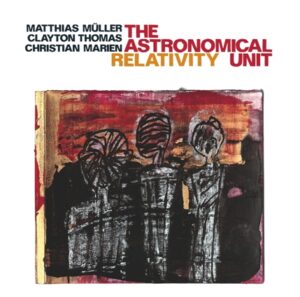CD jw 063 THE ASTRONOMICAL UNIT: RELATIVITY
CHRISTIAN MARIEN drums
MATTHIAS MÜLLER trombone
CLAYTON THOMAS double bass
Recorded March 3, 2008
DEU
Die Reise von Marien, Thomas und Müller setzt Imagination frei. Die unerwartete Reichhaltigkeit der Sounds macht vergessen, dass sich das Trio ohne weitere Hilfsmittel auf Posaune, Bass und Schlagzeug beschränkt. Das Vehikel wird zur Nebensache. Die Stille am Wegesrand gebiert immer wieder neue, faszinierende Klangkonstellationen. Die Musiker bewegen sich weiter, dem Hörer bietet sich jedoch Gelegenheit zum Eintauchen und Verweilen. Im Gegensatz zu den Akteuren haben wir Mitreisenden jederzeit Gelegenheit, nach Belieben auszusteigen und äußere Bewegung in innere Zustände zu übersetzen. Jeder Augenblick scheint die Ewigkeit zu transzendieren. Als Finale eröffnet sich ein grandioses Welttheater, den großen Momenten des Art Ensemble Of Chicago ebenbürtig. Das Trio streift die Strapazen des Weges ab und lässt sich fallen, gleichermaßen federleicht und tonnenschwer. Die Ankunft als sinnstiftendes Moment des Aufbruchs. Eine runde Sache. Bis der nächste Countdown eingezählt wird. Wolf Kampmann
ENG
Negating the cliché that three into two won’t go, bassist Clayton Thomas adds new textures to Relativity when his contributions expand the partnership of trombonist Matthias Müller and drummer Christian Marien showcased on Talk Talk. Recorded within eight months of one another, these CDs are actually parallel elaborations of a similar improvisational process within either two or three parts. The major difference may be that The Astronomical Unit (AU)’s four tracks use words in their titles while Superimpose’s six use letters. Although an augmented stratum of tension exists within the AU’s improvisation which are, in the main, staccato and agitato, that seems to be deliberate. Berlin-based Müller and Marien have worked as a duo since 2006 and as trio with Thomas since 2007. Initially members of the Olaf Ton band, Müller and Marien developed a common duo language from that experience. At the same time the trombonist collaborates with other musicians ranging from guitarist Olaf Rupp to multi-reedist Chris Heenan; while the drummer frequently works not only with musicians, but also with visual artists and dancers. An Australian turned Berliner, Thomas is now one of the busiest bassists in Central Europe, regularly working in combos featuring, among many others, French saxophonist Jean-Luc Guionnet and German trombonist Johannes Bauer. On their own, Müller and Marien have evolved a free, but somewhat cramped, strategy. Involving double counterpoint, it appears as if every tone or measure expressed by one player is immediately answered by the other one, and vice versa. Moving beyond call-and-response, the idea seems to be that, should for instance, the drummer output rim shots and sectional snaps, equally expressive vibrating tongue stretches emanating from deep within the trombone must appear as well. Should Müller create a rubato hocketing throat growl, then Marien’s response involves percussive flams, rolls or drags. With many tracks fading once concordance is reached, distinguishing tonal, features of these duets extend beyond technical instrumental quirks. Besides air propelled from his trombone in burps, snorts and sniffs, Müller also layers his improvisations with a unique form of onomatopoeia. Müller constantly hollers, mutters and mumbles under his breath in what could be the language of a secret society – or a Druid. Yet this parallel texture amplifies rather than supersedes his brass playing. Even when there are interludes of whistling grace notes or buried gutbucket growl from the trombonist, Marien’s ricocheting cymbal textures, off-side snare pressure or muscular bass drum beats speed up or slow down to meet the brass man’s expressions. Paradoxically, it appears that timbral expansion from the bassist’s bag of tricks opens up Relativity’s sound. These new timbres also contribute to a tauter trio interaction. Thick, rebounding stops plus slippery sawing on the bass’s strings with a license plate instead of a bow propel higher pitches and encourage Müller to be more adventurous. Subsequently hand-muting his bell for softer grace notes or thinning his tonal output to yelp, bark and bite encourages similar unprecedented expansions from the others. Marien’s response involves herky-jerky rubs and drags on his drum tops, protracted shuffle beats, and passages where strokes tick and pulse like an over-wound clock. For his part, Thomas uses powerful stopping and straightforward walking to prevent the contrapuntal triple improvisations from splintering or spinning out of control. While the sound journey on Relativity may appear to be more exhausting than the one which characterizes Talk Talk, each is memorable and praiseworthy. Ken Waxman

